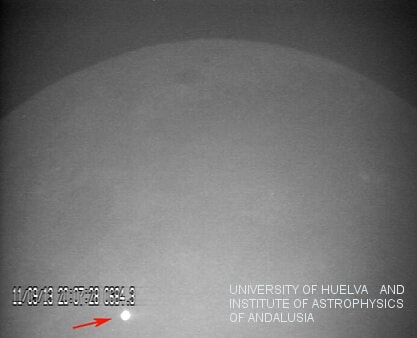The event took place in September 2013 but the Spanish researchers published it this week in the Journal of the Royal Astronomical Society in the UK. These impacts are another warning light of dangerous impacts from larger objects on Earth

A meteorite the weight of a small car crashed into the moon in September and was photographed by Spanish astronomers. The impact, the largest ever recorded, produced a bright flash and was clearly visible from Earth. The scientists published the description of the event in the Journal of the British Royal Astronomical Society.
The moon lacks an atmosphere like ours, which prevents small objects falling from space from reaching the earth's surface. The result is visible - a huge number of large and small craters covering the entire surface area of our nearest neighbor and documenting 4.5 billion years of collisions spanning the entire history of the solar system.
Although the chance of a large object colliding with the planets and moons is not high today, small collisions are common even today. The chances of accidentally observing such an event are slim, and therefore the scientists developed a network of telescopes capable of automatically detecting impacts on the moon.
On September 11, 2013, Prof. Jose Madedo operated two telescopes in southern Spain looking for impact events. At 20:07 GMT he witnessed a long bright flash in the Sea of Clouds (Mare Nubium), an ancient lava-filled basin, darker in appearance than its surroundings.
The flare was caused by a rock crashing into the surface of the moon and was almost as bright as the famous Pole Star, meaning that anyone on Earth who was lucky enough to be watching the moon at that moment could have seen it. In the video recording made by Prof. Madedo, the glow left after the impact is still visible from the Earth for another eight seconds.
The September event is the longest and brightest impact flare ever observed on the moon. "At that moment I realized that what I saw was an extraordinary and extremely rare event," said Madido.
The Spanish telescopes are part of the Moon Impacts Detection and Analysis System (MIDAS) that monitors the moon. The project is managed by Prof. Madido from the University of Huable and with him also Dr. Jose Ortiz from the Institute of Astrophysics of Andalusia and it continues a pioneering project to detect random impacts on the moon.
"Since these impacts occur at high speed, the rocks melt and vaporize at the impact site immediately. This process creates a thermal glow that can be detected from Earth through telescopes as short-lived flashes. Usually, these events last a fraction of a second, but the 11/XNUMX event was much more massive and lasted longer than any observed impact to date.
Madedo and Ortiz believe that the flash was created by a rock weighing about 400 kg and between 60 centimeters and 1.4 meters wide. The rock hit the sea of clouds at a speed of about 61 thousand km/h and created a new crater with a diameter of about 40 meters. The impact energy was equivalent to about 15 tons of TNT, at least 3 times more than The large impact observed by NASA in March 2013.
"Our telescopes will continue to observe the moon while our meteor cameras will monitor the Earth's atmosphere. In this way we expect to identify rock clusters that may be the source of common impact events on both planetary bodies. We also want to find out where the offending bodies come from."
Observing meteorite impacts on the Moon provides astronomers with insight into the risk of similar (but larger) objects impacting Earth. One of the conclusions of the Spanish team is that the frequency of hitting objects with a diameter of one meter or more is perhaps 10 times more common than previously thought. Fortunately, the Earth's atmosphere protects us from small rocks like the one that hit the sea of clouds, but they can lead to a spectacular meteor shower full of fireballs."
More of the topic in Hayadan:

4 תגובות
Kepler discovered 715 more amazing planets!!! Almost twice as much as we knew
A. Ben Ner
And what is it called when the bull throws it in the air? meteor??
In Spanish they say "matador". No? Even when he is on the ground.
The correct term is "meteorid". A meteorite is a part of a meteorite (or a whole meteorite) that is on the surface of the earth.